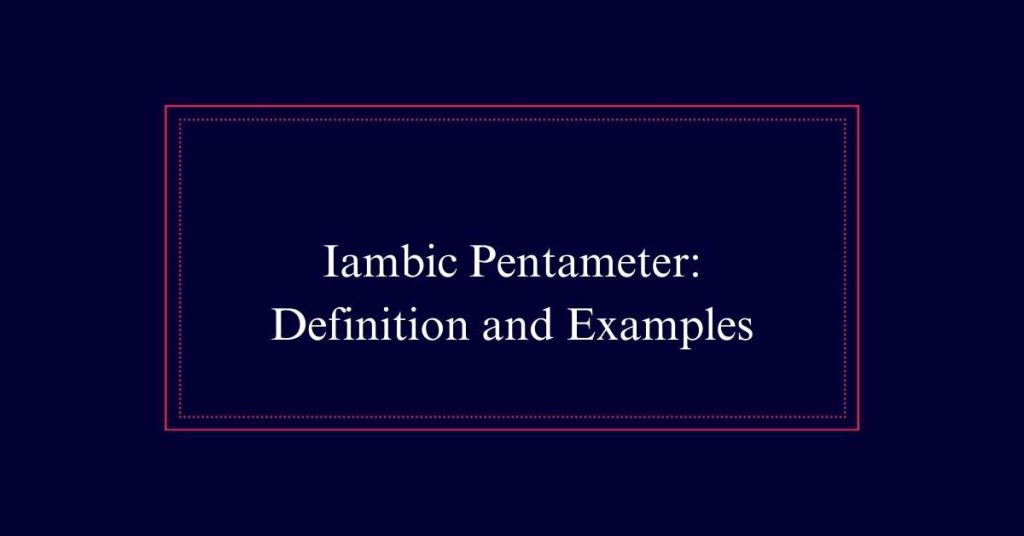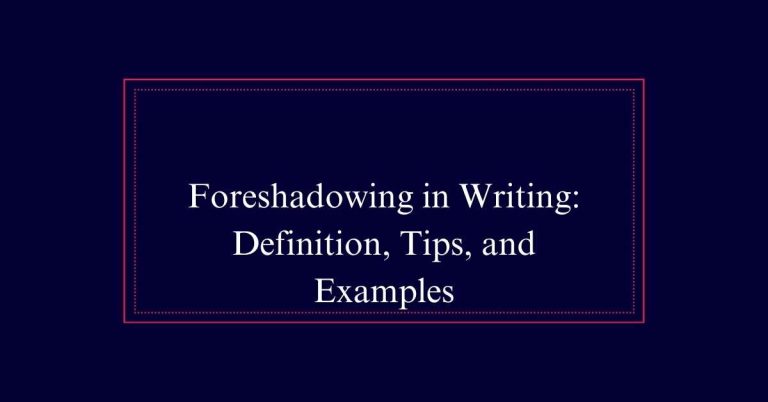Iambic Pentameter: Definition and Examples
Iambic pentameter is a rhythmic pattern used in English poetry that consists of lines with ten syllables each. These syllables are arranged in five pairs called iambs, where each pair has one unstressed syllable followed by a stressed syllable. This pattern creates a musical cadence that enhances the flow and readability of poetry. Famous poets like Shakespeare utilized iambic pentameter to mirror natural speech and add emotional depth to their work.
What Is Iambic Pentameter?
Iambic pentameter is a rhythmic pattern in poetry that consists of ten syllables per line, alternating between unstressed and stressed syllables. This pattern creates a musical cadence and flow in the writing.
Each line has five metrical feet, known as iambs, where each iamb consists of an unstressed syllable followed by a stressed one. The term ‘pentameter’ refers to the five metrical feet in each line. This structure provides a consistent rhythm that enhances the readability and memorability of the poetry.
Shakespeare’s works are famous examples, showcasing how this form can emphasize certain words and ideas. Iambic pentameter is a cornerstone of English poetry, reflecting both tradition and creative expression.
Rhythmic Pattern Explained
The rhythmic pattern of iambic pentameter consists of alternating unstressed and stressed syllables across ten syllables per line. This structure creates a flowing and harmonious rhythm that has been cherished by poets for centuries. The pattern is known for its musicality and consistency, making it a foundational tool in English poetry.
| Emotion | Effect | Example |
|---|---|---|
| Calm | Soothing rhythm | “To be, or not to be” |
| Passion | Emphatic stress | “Shall I compare thee” |
| Reflection | Meditative flow | “When I consider” |
Stress and Unstress Syllables
Understanding the interplay between stressed and unstressed syllables is essential for mastering iambic pentameter. This meter relies on a pattern where each line consists of ten syllables, divided into five pairs called iambs. Each iamb contains one unstressed syllable followed by a stressed syllable. This alternation creates a rhythm that mimics natural speech.
To identify stressed and unstressed syllables, consider the following steps:
- Listen for Natural Emphasis: In speech, some syllables are naturally emphasized.
- Mark the Syllables: Use symbols like `/` for stressed and `˘` for unstressed.
- Practice with Examples: Read lines of iambic pentameter aloud to internalize the rhythm.
Shakespeare’s Use of Iambic Pentameter
Shakespeare masterfully employed iambic pentameter to elevate the rhythm and emotion of his works. This meter, with its alternating stressed and unstressed syllables, allowed Shakespeare to mirror natural speech patterns while adding a musical quality to his lines. By using iambic pentameter, he could emphasize key words and create a dynamic flow within dialogues and soliloquies.

Here is a table showing examples:
| Play | Famous Line |
|---|---|
| Hamlet | “To be, or not to be, that is the question.” |
| Romeo and Juliet | “But, soft! what light through yonder window breaks? |
| Sonnet 18 | “Shall I compare thee to a summer’s day?” |
| Macbeth | Is this a dagger which I see before me?” |
Establishing Order and Flow
Establishing order and flow in writing often hinges on the rhythmic structure provided by iambic pentameter. This meter, with its alternating stressed and unstressed syllables, creates a natural cadence that enhances readability. Iambic pentameter’s consistency helps writers maintain a structured rhythm, making the text more engaging and easier to follow.
Key benefits include:
- Predictable Rhythm: The regular pattern aids in creating a musical quality.
- Enhanced Emphasis: Certain words or ideas can be highlighted through strategic placement.
- Consistency: A uniform meter helps in maintaining a smooth narrative flow.
Writing Iambic Pentameter
How does one begin to craft a line in iambic pentameter? Start by understanding its structure. Each line contains ten syllables, divided into five pairs called metrical feet.
These pairs consist of an unstressed syllable followed by a stressed syllable. To practice, think of natural speech patterns. For example, say ‘I wake to find the world is full of light.’ Notice how the stress falls naturally on every second syllable.
Writing in iambic pentameter requires this rhythmic discipline. Initially, draft your lines without worrying about perfection. Then, review to make sure the pattern holds.
Understanding Metrical Feet
To fully master iambic pentameter, one must grasp the concept of metrical feet. Metrical feet are the building blocks of poetic meter. In iambic pentameter, each foot consists of one unstressed syllable followed by one stressed syllable, known as an iamb. Understanding these feet is essential for creating the rhythmic pattern that defines iambic pentameter.
Here are three key points to remember:
- Definition: A metrical foot is a unit of rhythm in poetry.
- Types: The iamb (unstressed-stressed) is just one type of metrical foot; others include trochees (stressed-unstressed) and anapests (unstressed-unstressed-stressed).
- Application: In iambic pentameter, each line contains five iambic feet, totaling ten syllables.
Shakespeare’s Creative Challenge
Shakespeare’s use of iambic pentameter presented a creative challenge that shaped his poetic and dramatic works. It required careful attention to rhythm and word choice. Each line had to fit the pattern of unstressed and stressed syllables, creating a musical quality.
This structure forced Shakespeare to be inventive with language. He used the constraints to enhance the emotional impact of his lines. The rhythm mirrored natural speech, making his dialogue more engaging. His mastery of this form set his work apart.
It allowed him to convey complex ideas and emotions within a strict framework. This creative challenge elevated his works and contributed to their enduring legacy.
Tradition and History
Iambic pentameter has deep roots in the tradition and history of English poetry. It gained prominence in the sixteenth century, becoming a hallmark of Renaissance literature. Its rhythmic pattern mirrored the spoken English of the time, making it both natural and musical. Shakespeare popularized its use, embedding it in many of his plays and sonnets.
Key reasons for its historical significance include:
- Mirroring Natural Speech: It closely resembles the rhythm of natural English speech.
- Creative Structure: It provided poets with a challenging yet structured form.
- Cultural Prestige: It became synonymous with high literary art, especially during the Renaissance.
Modern Examples of Iambic Pentameter
Despite its historical roots, iambic pentameter continues to thrive in modern poetry and other creative mediums. Contemporary poets like Carol Ann Duffy use it to add rhythm and depth to their work.
Songwriters such as Kate Bush and Leonard Cohen also incorporate iambic pentameter, enhancing the musicality of their lyrics.
In modern literature, authors like John Updike and Ian McEwan employ this meter to create a structured, flowing narrative. These examples demonstrate the versatility and enduring appeal of iambic pentameter.
Whether in poetry, music, or prose, the rhythmic pattern of ten syllables per line still provides a timeless cadence that enriches modern creative expression.






